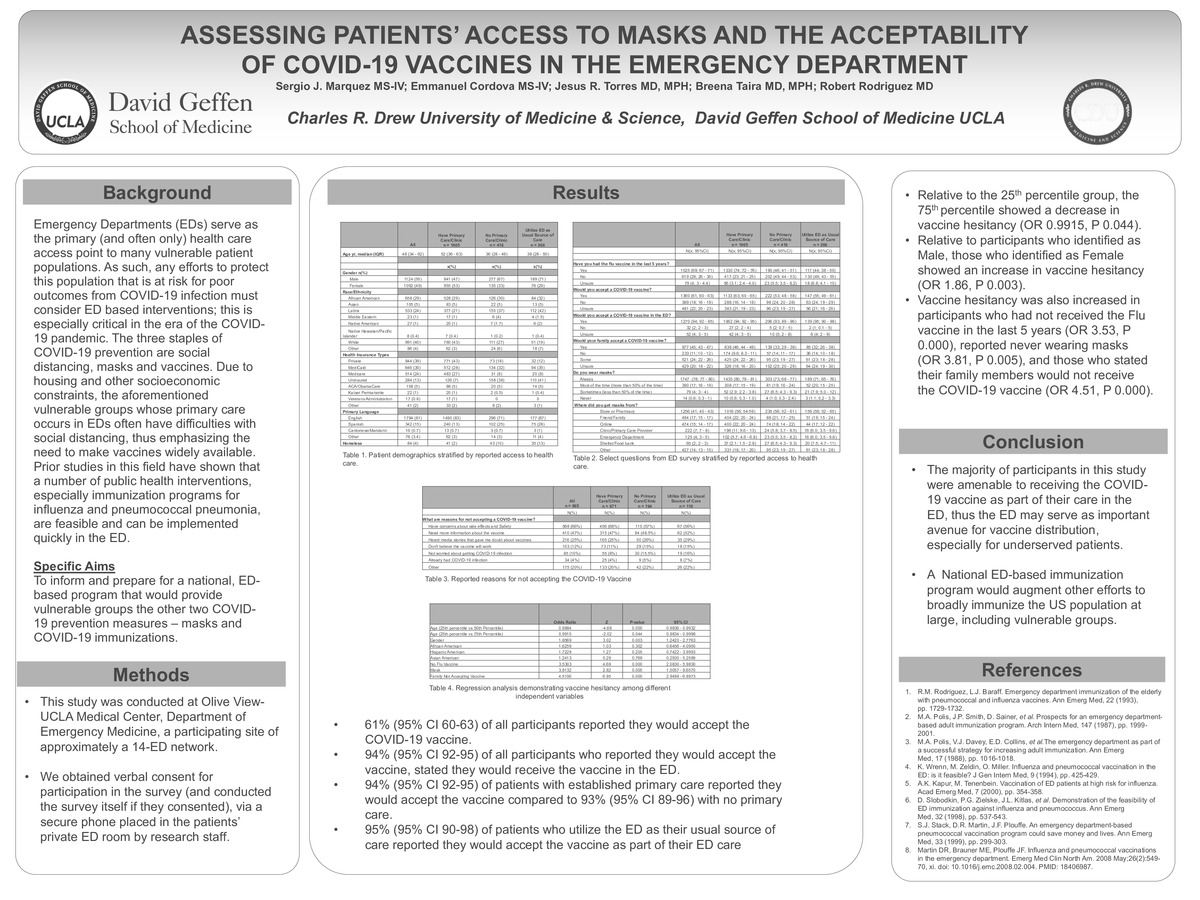-
Author
Sergio Marquez -
Co-author
Jesus R. Torres, MD, MPH; Breena Taira, MD, MPH; Robert Rodriguez, MD
-
Title
Assessing patients’ access to masks and the acceptability of COVID-19 vaccines in the emergency department
-
Abstract
Assessing patients’ access to masks and the acceptability of COVID-19 vaccines in the emergency department
Sergio J. Marquez, MS-IV; Jesus R. Torres, MD, MPH; Breena Taira MD, MPH; Robert Rodriguez, MD
Emergency Departments (EDs) serve as the primary (and often only) health care access point to many vulnerable patient populations. As such, any efforts to protect this population that is at risk for poor outcomes from COVID-19 infection must consider ED based interventions; this is especially critical in the era of the COVID-19 pandemic. The three staples of COVID-19 prevention are social distancing, masks and vaccines. Due to housing and other socioeconomic constraints, the aforementioned vulnerable groups whose primary care occurs in EDs often have difficulties with social distancing, thus emphasizing the need to make vaccines widely available. Prior studies in this field have shown that a number of public health interventions, especially immunization programs for influenza and pneumococcal pneumonia, are feasible and can be implemented quickly in the ED. Our study was a multicenter qualitative survey study at the Olive-View UCLA Medical Center, Emergency Department. Results showed that 61% (95% CI 60-63) of all participants reported they would accept the COVID-19 vaccine. Furthermore, 94% (95% CI 92-95) of all participants who reported they would accept the vaccine, stated they would receive the vaccine in the ED. The majority of participants in this study were amenable to receiving the COVID-19 vaccine as part of their care in the ED, thus the ED may serve as important avenue for vaccine distribution, especially for underserved patients.
Literature Cited
- R.M. Rodriguez, L.J. Baraff. Emergency department immunization of the elderly with pneumococcal and influenza vaccines. Ann Emerg Med, 22 (1993), pp. 1729-1732
- M.A. Polis, J.P. Smith, D. Sainer, et al. Prospects for an emergency department-based adult immunization program. Arch Intern Med, 147 (1987), pp. 1999-2001
- M.A. Polis, V.J. Davey, E.D. Collins, et al.The emergency department as part of a successful strategy for increasing adult immunization. Ann Emerg Med, 17 (1988), pp. 1016-1018
- K. Wrenn, M. Zeldin, O. Miller. Influenza and pneumococcal vaccination in the ED: is it feasible? J Gen Intern Med, 9 (1994), pp. 425-429
- A.K. Kapur, M. Tenenbein. Vaccination of ED patients at high risk for influenzaAcad Emerg Med, 7 (2000), pp. 354-358.
- D. Slobodkin, P.G. Zielske, J.L. Kitlas, et al. Demonstration of the feasibility of ED immunization against influenza and pneumococcus. Ann Emerg Med, 32 (1998), pp. 537-543
- S.J. Stack, D.R. Martin, J.F. Plouffe. An emergency department-based pneumococcal vaccination program could save money and livesAnn Emerg Med, 33 (1999), pp. 299-303.
- Martin DR, Brauner ME, Plouffe JF. Influenza and pneumococcal vaccinations in the emergency department. Emerg Med Clin North Am. 2008 May;26(2):549-70, xi. doi: 10.1016/j.emc.2008.02.004. PMID: 18406987.
-
College
UUC
-
Zoom
-
PDF

